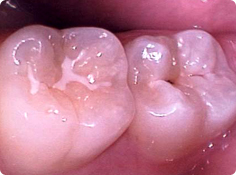| Tooth
decay is the most wide-spread dental problem among
children and young adults. However, your dentist can
help prevent or reduce the incidence of decay by applying
sealants to your child's teeth.
What is a Sealant?
A Sealant is a plastic material that is applied to
the chewing surfaces of the back teeth, where decay
occurs most often. This sealant acts as a barrier,
protecting the decay-prone areas of the back teeth
from plaque and acid.
Why are Sealants Necessary?
When the back teeth are developing, depressions and
grooves form in the chewing surfaces of the enamel.
These irregularities are called pits and fissures.
They are impossible to keep clean, because the bristles
of a toothbrush cannot reach into them (diagram below).
Therefore, pits and fissures are snug places for plaque
and bits of food to hide. By forming a thin covering
over the pits and fissures, sealants keep out plaque
and food, and thus decrease the risk of decay.
Who should have Sealants
Applied?
Children receive the greatest benefit from having
sealants applied to their teeth, especially to newly
erupted permanent teeth. Sealants are recommended
for all children, after the age of ten, even those
who receive topical applications of fluoride or who
live in communities with fluoridated water. Fluoride
helps fight decay on the smooth surfaces of the teeth,
and is not so effective in the pits and fissures.
How are Sealants Applied?
Each tooth takes only a few minutes to seal. First,
the teeth to be sealed are cleaned and then chemically
treated to help the sealant adhere to the teeth. Finally,
the sealant is brushed on the tooth enamel and allowed
to harden by exposing it to ultra-violet light.
This photograph shows one tooth treated with sealant,
while in the other tooth the process of decay has
started.
Do Sealants need to
be Replaced?
When sealant is applied, finger-like strands penetrate
the pits and fissures of the tooth enamel. Although
the effect of the sealant cannot be seen with the
naked eye, the protective effect of these strands
continues. As a result, it may be several years before
another application of sealant is needed. Re-application
of the sealant will continue its protection against
decay and may save the time and expense of having
a tooth restored. Sealants are checked during your
child's regular dental recall visit to determine if
re-application is necessary.
It is recognized the world over that sealants can
play an important role in the prevention of tooth
decay. When properly applied and maintained, they
can successfully protect the chewing surfaces of your
child's teeth. A total prevention program includes
regular visits to your dentist, the use of fluoride,
daily brushing and flossing, and limiting the number
of times sugar-rich foods are eaten. If these measures
are followed and sealants are used on your child's
teeth as well, the risk of decay can be reduced or
may even be eliminated !
Topics of Interest
|